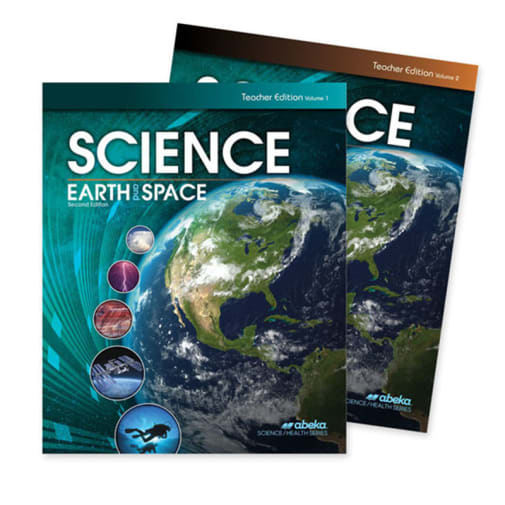The course teacher guide is divided into two volumes. It includes a scope and sequence, daily lesson plans, and reduced student pages with teaching notes for each chapter. Lesson plans include a teacher preparation and procedures section to help parents more efficiently prepare for class time. Also included are teaching notes with chapter overviews, lab notes, in-class activities ideas, section review answers, and additional information to enrich your lessons. Highly recommended for comprehensive instruction, the teacher guides are available individually or in a set. Volume One covers chapters 1-6 and Volume Two covers 7-13. If you prefer not to invest in the teacher guides, there is an Earth and Space Answer Key available, which provides answers to the text questions.
Abeka Science: Earth and Space Teacher Edition Volumes 1 & 2
Description
Open your 8th grader's eyes to the wonders of geology, oceanography, meteorology, and more with our Science: Earth and Space Teacher Edition Volumes 1 and 2—Revised! This special teacher's edition is fully equipped with a scope and sequence for the course, daily lesson plans, and teaching notes for each chapter. The scope and sequence helps you plan ahead by giving you an overview of the science course. Each lesson plan includes sections such as "Preparation" and "Teaching Procedure" that allow you to spend less time planning and more time teaching. The teaching notes include chapter overviews, lab notes, in-class activity ideas, section review answers, and additional information to enrich your lessons. These volumes cover chapters 1-12 of Science: Earth and Space.
Beginning with a foundational understanding of the scientific method, students learn about soil science, geology, earthquakes, volcanoes, rocks and minerals, erosion, fossils, oceanography, the atmosphere, weather, astronomy, the universe, and environmental science. A creation worldview is evident throughout in the highlighted "creation clips" and the in-depth comparison of evolutionary theory and biblical creation in the chapter on interpreting the fossil record. Daily lessons will take about 50 minutes, although some students may need longer.
The student textbook provides textual readings, section and chapter reviews, and investigations (hands-on activities). Space to record answers is not included, so students will need a separate notebook. You will need to provide numerous items – some are common and easy to find, while others are household and lab specific supplies. Examples of required supplies include a 400x stereo microscope, iodine, forceps, spring scale, planarians, petri dishes, test tubes, eye dropper or pipette, scalpel, microscope slides and coverslips, elodea, cork, a Celsius thermometer, etc.
The course teacher guide is divided into two volumes. It includes a scope and sequence, daily lesson plans, and reduced student pages with teaching notes for each chapter. Lesson plans include a teacher preparation and procedures section to help parents more efficiently prepare for class time. Also included are teaching notes with chapter overviews, lab notes, in-class activities ideas, section review answers, and additional information to enrich your lessons. Highly recommended for comprehensive instruction, the teacher guides are available individually or in a set. Volume One covers chapters 1-6 and Volume Two covers 7-13. If you prefer not to invest in the teacher guides, there is an Earth and Space Answer Key available, which provides answers to the text questions.
Additional resources include the Quiz Book, Test Book, and the Activity Book. Answers are not included, and each book has a separate answer key. The test book provides a grading overview and a wide range of questions to assess understanding of concepts. Short answer, multiple choice, matching, true or false, and essay questions are included on each test. The quiz book includes 36 quizzes with matching, true or false, and short answer questions. The activity book offers a variety of activities from puzzles to labeling, matching, or providing short answers. Also included are instructions and resources to complete a STEM project. Answers for each student resource is found in the corresponding answer keys. Student and teacher resources are not reproducible.
Also available to simplify your purchase are Student and Parent Kits. The Student Kit contains the textbook, test book, quiz book, and the activity book with STEM project resources. The Parent Kit includes the Volume 1 and Volume 2 Teacher Editions, the Test Key, Quiz Key, and the Activity Book Key.
| Product Format: | Paperback |
|---|---|
| Grade: | 8 |
| Brand: | Abeka |
| ISBN: | 9780000321695 |
| Length in Inches: | 3 |
| Width in Inches: | 13.5 |
| Height in Inches: | 10.5 |
| Weight in Pounds: | 3.3 |

